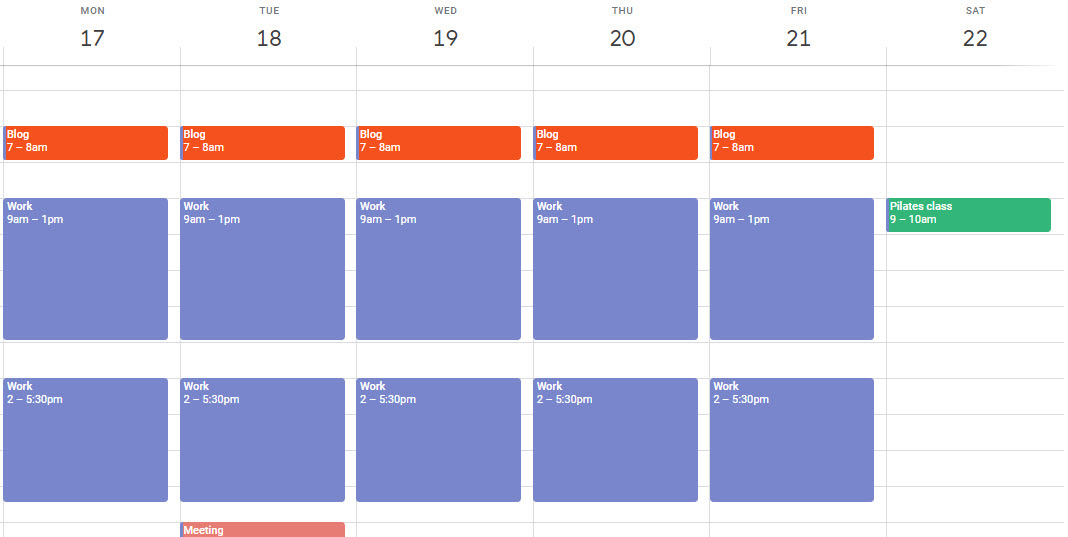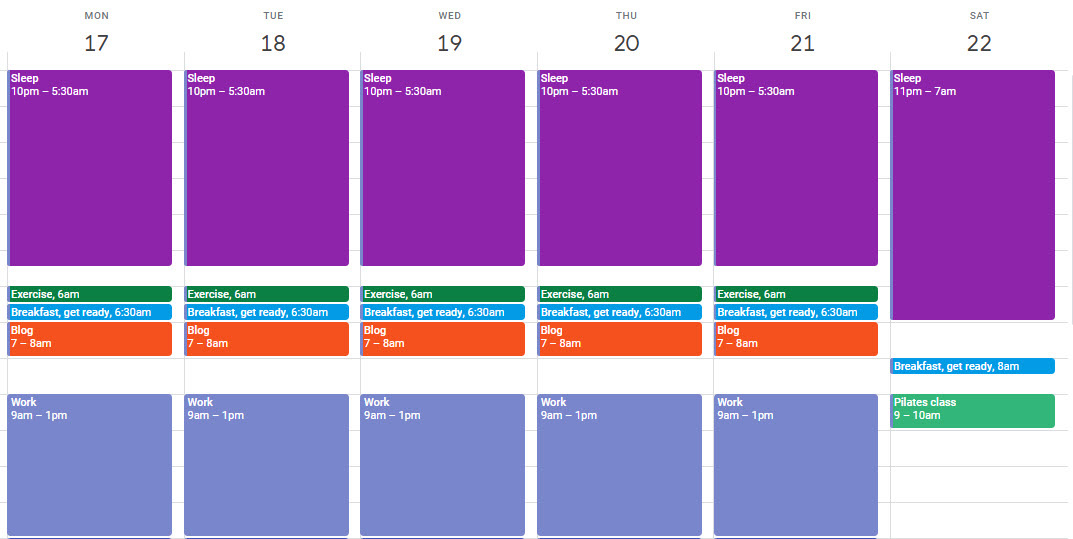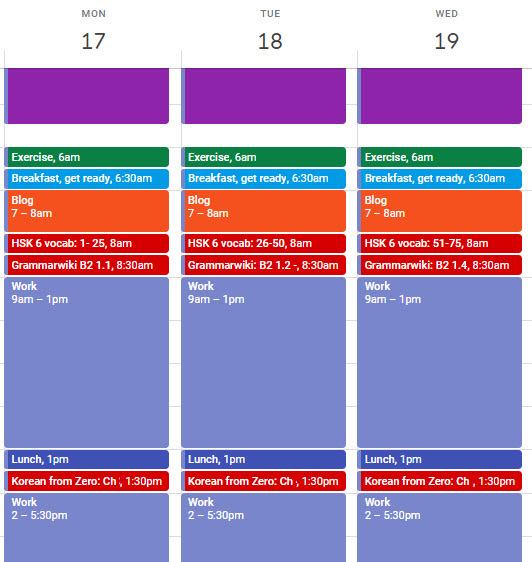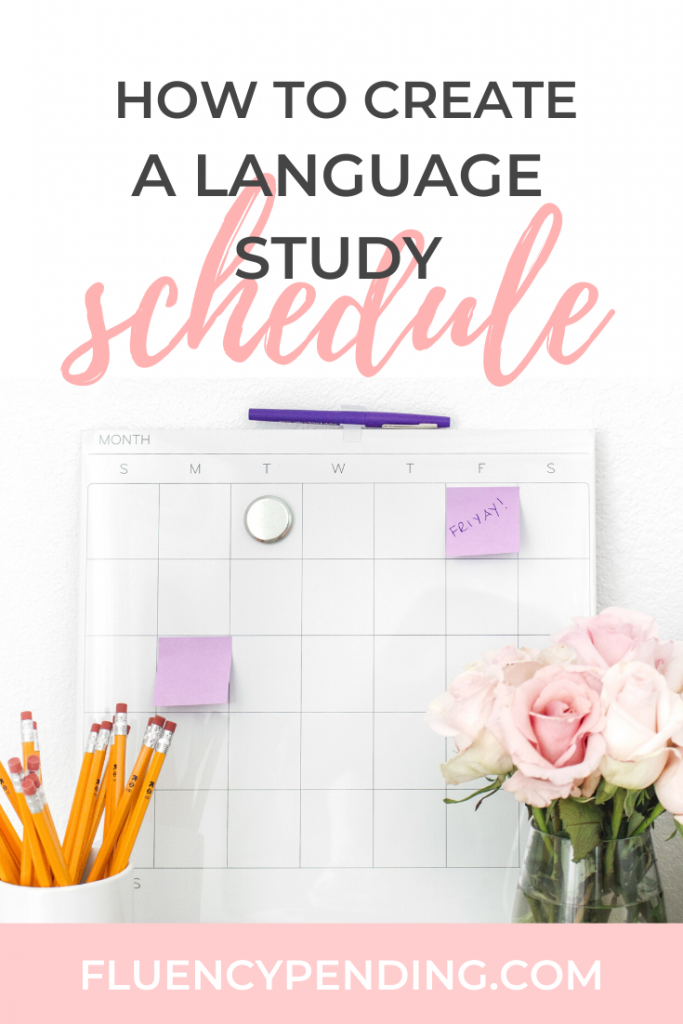
How to Create a Language Learning Study Schedule
Please keep in mind that some of the links in this post are affiliate links. In the event of a sale, I will be awarded a small commission (at no extra cost for you). Thank you for supporting my blog!
So, you’re trying to learn a new language but you feel like there just aren’t enough hours in the day to make any real progress.
Welcome to the club, my friend. What with a full-time job (gotta pay those bills), this blog, freelance gigs, a house so disorderly it will have Marie Kondo weeping into her perfectly pressed silk handkerchief and a husband who occasionally demands my attention, I have no time.
The solution to all this chaos? You need a language learning study schedule!
A well-planned study schedule can help you make the most of your very limited time, keep sane and stay on track with your goals.
Follow my step-by-step guide to setting up a language learning study schedule and optimise your daily routine.
Step 1: Set study goals
I know, I know. I’ve been banging on about setting goals for a while now but this is an important first step if you want to get the most out of your study schedule.
Everyone’s process is different, but here’s how I go about setting study goals.
Firstly, I decide what I want to achieve in the next six months for both my active languages.
For example:
- Mandarin: I want to focus on getting my comprehension level up so I can consume more interesting native material.
- Korean: I want to build a solid foundation by getting to grips with Hangul and learning basic vocabulary and grammar patterns.
Then I decide what resources I am going to need to achieve these goals and break them down into actionable steps.
For example:
Mandarin:
- Review all the HSK 6 vocabulary words (2500) and finally make them stick
- Work through all of the Chinese Grammar Wiki B2 grammar points
- Read one novel to increase reading comprehension
Korean:
- Work through the Korean from Zero 1 textbook
Next, I’ll break these down further into 25 minute Pomodoro study slots. For my Mandarin goal, this may look something like this:
- HSK 6 vocabulary: review words 1-25
- B2 grammar points: review section 1.1 (adjectives)
- Reading: Page 1 intensive reading
We’re going to look at how to schedule these study slots into your daily routine in step 5.
Step 2: Block out existing commitments
For the next step, you’re going to need some sort of calendar. I’m going to use Google calendar for this, but you can use whatever works for you. I’ll talk a little about the tools you can use to track your study schedule in a later section.
First, we’re going to block out existing commitments in your calendar. This includes non-negotiable obligations like work hours, classes, school work and pre-arranged social engagements.
You’ll end up with something like this:

In my example, I’ve used the weekly view on my Google calendar. You can also plan monthly or even further ahead if you prefer.
Step 3: Strike a balance
Next, block out time for the things that will make you a functioning human being, such as exercise, meals, sleeping, relaxation and socialising.
You may be fired up to study as much as you can to reach your goals sooner, but you’ll lose your motivation very quickly if you don’t make time for a balanced lifestyle. All work and no play and all that…

Note: If you don’t want Google reminders for everyday activities such as going to bed or work, you can always remove these later. This is to give you an accurate idea of how much time you actually have to spend on studying.
Step 4: Optimise your time
By now your schedule should be pretty stacked and you may feel that this just confirms that you have no time for studying.
Look again. Where are you spending your time? Where can you cut? Can you get up earlier? Can you limit the time spent binging Netflix or playing games?
Rework your schedule now if you feel you haven’t made the most of your available time. Remember that we’re aiming to strike a good balance, so don’t cut down on important things like getting enough sleep.
Step 5: Slot in study blocks
Now that you have a better idea of how much time you actually have for studying, you can schedule your study blocks. Using the curriculum you set yourself in step 1, slot in your 25-minute Pomodoro study sessions, leaving time for breaks in between.
You can also look at the blocks that have already been allocated in the previous steps to see if there are any opportunities for multi-tasking. For example, you could listen to a podcast while you’re hitting the treadmill or review flashcards on your commute.
Here you can also include some review blocks to consolidate what you’ve been learning.
If you’re doing a formal language course, remember to prioritise any deadlines and exams.
In a perfect world where I never oversleep or have lunch time meetings, my schedule now looks something like this:

You’ll notice that I focus on Chinese and Korean at different times of the day. Some people prefer to set aside specific days for different languages (e.g. German on Monday, Russian on Tuesday) but this is entirely up to you.
Also, if you’re wondering why I don’t have a commute, it’s because I work from home.
Step 6: Review
Once a month (or week or whatever works for you) set aside some time to review your goals and update your schedule.
What worked and what didn’t? Perhaps you found it difficult to stick to your schedule because you were too optimistic and over-extended yourself. Make a few adjustments. It may take a few iterations before you settle on a schedule that’s right for you.
Tips for sticking to your schedule
- Be flexible. Unexpected things tend to crop up and you will inevitably miss a study session or two. When this happens, immediately reschedule the study session so you don’t fall behind.
- Put your schedule somewhere where you can see it. Set reminders on your phone or stick it to your fridge or your mirror. You are less likely to follow a schedule if you don’t have eyes on it.
- Try to schedule your study slots for the same time every day so it becomes a habit
- Get a reliable study buddy. Studying with someone with the same goals and work ethic will help keep you accountable.
- Share your schedule with those close to you so they know not to tempt you with fun activities during those times.
- Figure out what time of day you are most productive. If you’re more energised in the mornings (lucky you) there’s no point in scheduling study time at midnight when you’re dull and sluggish.
- If you’re a full-time student, treat your language as one of your subjects and schedule study time as you would for your other classes.
- Keep your study space clean and free of distractions.
- Plan a reward for when you hit your goals.
Apps and resources to use:
- Trello – I love Trello for keeping track of my work and blog projects.You can use your free power-up to get the calendar function.
- Google Calendar – Free and simple to use as in my examples above.
- Bullet journal/diary – Great if you’re more of a pen and paper person. Check out this bullet journal kit
- My Study Life – A free app that lets you organise all your classes, tasks, assignments and timetable.
- Digital journal – There are so many cute digital journals out there. I have my eye on the 2020 Digital Planner from The Pink Ink. You can also create your own on the Keynote app or in PowerPoint.
- Asana – An amazing work management application. The basic version is free.
Do you have a language learning schedule? How do you stick to it?






7 Comments
Jen
February 19, 2020 at 7:16 pm
My husband has been wanting to get back into learning Dutch again, so I will have to share this. Thanks for the great tips!
Elzette
February 20, 2020 at 8:33 am
Thanks for reading, Jen. I hope your husband finds it useful!
Is it Possible to Learn Multiple Languages at Once? (from someone who’s perpetually learning six) – The Curious Linguist
August 3, 2020 at 8:15 pm
[…] definitely not my area of expertise, but if that’s something that would be helpful for you, here’s an article to get you […]
Lola
September 26, 2020 at 3:43 pm
Thanks for a really useful post! I have been following this advice for a few months and it works really well! I don’t always stick to it very well, but the pomodoro slots really help. I really appreciate the tips!
Elzette
September 28, 2020 at 9:54 am
I’m so glad you found it useful, Lola!
Juna
October 5, 2020 at 6:03 pm
Thanks for the tips! I’m travelling to S. Korea next year to study in a university for a whole semester, so I aim to learn at least HTSK’s Unit 1 (beginner). This is truly useful. Thank you!
Elzette
October 6, 2020 at 7:39 am
That’s so exciting, Juna! I’m so glad you found this useful. Good luck with your Korean studies!
Comments are closed